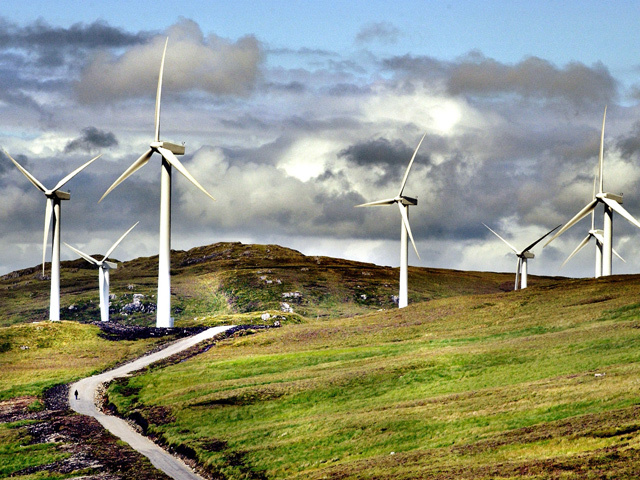
The march of wind turbines was laid bare last night as it was revealed that they are visible from nearly half of Scotland.
New figures show that the renewable energy towers can be seen from 41.7% of the countryside compared to 19.9% five years ago.
Protesters warned the situation would get much worse in years to come because the data – released by Scottish Natural Heritage – did not take into account the number of developments now being considered by planning authorities.
New maps have also been released showing the number of windfarm developments in the Scottish countryside – and how many more are to come.
These showed that 115 of the schemes have already been approved or built in the north, east and west of the country.
An additional 70 applications have been lodged with planning authorities and 92 sites are being assessed for turbine suitability.
Niall Stuart, chief executive of trade body Scottish Renewables, claimed two-thirds of people in Scotland and the UK wanted to see more wind-power projects to lower carbon emissions and tackle global warming.
But anti-windfarm campaigner Lyndsey Ward described the situation as “horrific” and urged First Minister Alex Salmond to “get a grip” because his government was “systematically destroying” rural Scotland and the tourism industry was under undeniable threat.
“What people do not understand is that this is the tip of the iceberg,” she said.
“There are literally hundreds of turbines that are approved but yet to be built or in the planning system.”
READ MORE
Infographic: Growth of windfarm sites across north Scotland since 2008
Windfarm growth ‘will add to unease’ of chasing renewable targets, warns council boss
Graham Lang, chairman of pressure group Scotland Against Spin, said: “People viewing this data will be shocked to the core.
“The question is how long the government can carry on promoting this epic disaster?”
Stuart Young, of the Caithness Windfarm Information Forum, described the situation as “ghastly” and asked: “Who cares about Scotland any more?”
Highland councillor Jim Crawford said he was “horrified”.
“I can’t think of any country which would sabotage their natural environment, which is a priceless asset for Scotland,” he said. “This is completely unsustainable.”
The maps show that 47 windfarms have been approved or installed in eastern Scotland, which covers Aberdeenshire and Moray.
A total of 35 developments are at the application stage and 35 so-called scoping projects are under way.
In the western sector, which covers most of the Highlands and Western Isles, 30 windfarms have been approved or installed, 13 applications are being considered and 25 scoping projects are being carried out.
The maps show that 38 windfarms have been approved or installed in the Northern Isles, 22 applications are being considered and 32 scoping projects are under way.
Murdo Fraser, convener of Holyrood’s energy committee, said: “Those already concerned at the spread of windfarms will be alarmed at the number of turbine applications currently in the planning and scoping stages.
“A turbine development on the banks of Loch Ness is in the planning stages. In an area of such cultural and economic importance, there can be no sense in endangering the local economy and scenic beauty of the region for the false promises of onshore wind.”
The Mid Scotland and Fife Conservative MSP said the government must understand the relationship between tourism, rural beauty and the impact of wind turbines.
“Therefore, planning regulations must go much further to protect Scotland’s countryside from unsightly and unsuitable wind developments,” he said.
A Scottish Government spokesman said the SNH visibility data was based on a theo-retical model and the results should be considered with a “degree of caution”.
“We recognise that we must provide appropriate protection for our landscapes and it has set out in draft Scottish planning policy proposals that no windfarms would be allowed in national parks or national scenic areas,” he added.
The spokesman said councils may be able to secure protection for landscapes if it can be demonstrated the area is faced with the cumulat
Murdo Fraser, convener of Holyrood’s energy committee, said: “Those already concerned at the spread of windfarms will be alarmed at the number of turbine applications currently in the planning and scoping stages.
“A turbine development on the banks of Loch Ness is in the planning stages. In an area of such cultural and economic importance, there can be no sense in endangering the local economy and scenic beauty of the region for the false promises of onshore wind.”
The Mid Scotland and Fife Conservative MSP said the government must understand the relationship between tourism, rural beauty and the impact of wind turbines.
“Therefore, planning regulations must go much further to protect Scotland’s countryside from unsightly and unsuitable wind developments,” he said.
A Scottish Government spokesman said the SNH visibility data was based on a theo-retical model and the results should be considered with a “degree of caution”.
“We recognise that we must provide appropriate protection for our landscapes and it has set out in draft Scottish planning policy proposals that no windfarms would be allowed in national parks or national scenic areas,” he added.
The spokesman said councils may be able to secure protection for landscapes if it can be demonstrated the area is faced with the cumulative impact of windfarms.
Recommended for you
